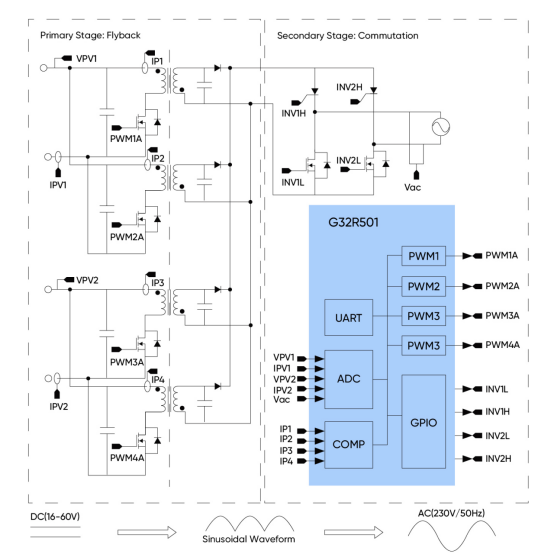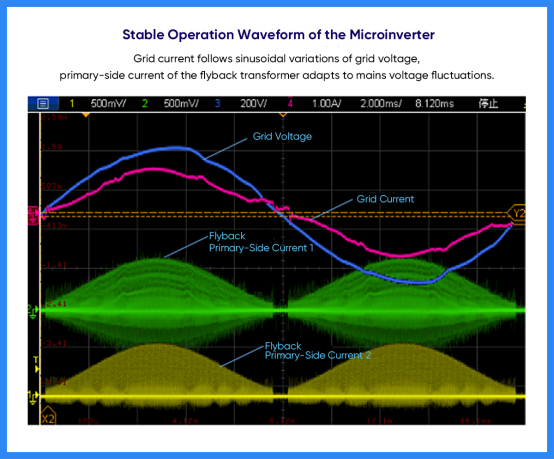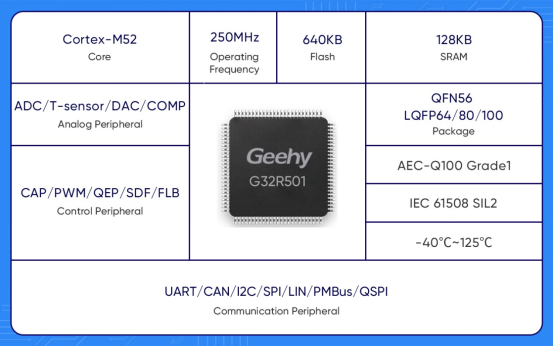In response to the growing global demand for renewable energy, particularly in distributed generation and residential solar storage systems, the microinverter market has expanded significantly, now reaching a billion-dollar scale. As a crucial component in solar energy systems, microinverters enable efficient energy conversion and grid connectivity, advancing green energy adoption.
Geehy introduces the G32R501 800W Dual MPPT Microinverter Solution, a high-efficiency, intelligent production-ready solution designed to support the global energy transition. Leveraging the G32R501 real-time MCU, this solution enables digital control of photovoltaic (PV) microinverters, featuring dual independent Maximum Power Point Tracking (MPPT) inputs, an 800W rated power output, Phase-Locked Loop (PLL) grid synchronization, and seamless grid-tied operation.

G32R501 800W Dual MPPT Microinverter Solution Overview
The Geehy G32R501-based microinverter solution integrates all essential functions for microinverter applications. The G32R501 real-time MCU manages MPPT tracking, grid synchronization (SPLL), primary-side current tracking of the flyback converter, sinusoidal voltage regulation, and external USART communication. It also controls two power units for isolated flyback conversion and output commutation.
Solution Features
· Utilizes the G32R501 real-time MCU for full digital control of flyback and commutation power units.
· Maximum photovoltaic input voltage: 60V; MPPT voltage range: 16V–60V; startup voltage: 22V; dual MPPT channels; maximum input current: 14A.
· Supports grid voltage range of AC 180V–275V and frequency of 45Hz–55Hz.
· Rated output power: 800W; rated output current: 3.5A.
· Full-load power factor >0.99; peak efficiency: 94.0%.
· Nominal MPPT efficiency: 99.80%.
· Operating temperature: -40℃ to 60℃, natural cooling.

Solution Functions
This solution incorporates a flyback power unit and a commutation power unit, using the G32R501 real-time MCU to enable photovoltaic grid connection output.
The flyback power unit consists of two identical flyback circuits operating in a two-phase interleaved parallel mode to optimize power transmission and MPPT efficiency. It ensures precise primary-side current regulation and synchronized sinusoidal grid voltage tracking for high power factor output.
The commutation power unit uses an H-bridge with two bridge arms, each containing a MOSFET and a thyristor in series. A PLL generates the flyback unit’s angle and controls the four switches for sinusoidal current output.
The dual MPPT channels operate independently, mitigating power loss caused by mismatched PV modules (for example, shading and varying irradiation angles), thereby enhancing energy yield by at least 5%.
Ensures system stability and efficiency even in the scenario of individual module failure or inverter malfunction.
Enables flexible installation for PV modules with different orientations, slopes, and power ratings, facilitating the integration of both new and existing equipment.

G32R501 Chip Features
· High Computing Power: With a 250 MHz operating frequency, SRAM can be flexibly configured as zero-wait-state ITCM and DTCM. The Arm® Cortex®-M52 core supports ACI functionality, allowing direct integration of custom instructions, and significantly enhancing computational performance for power applications like filters, compensators, and PLLs.
· Advanced Control Peripherals: Equipped with 16 PWM channels supporting high-resolution PWM output (typical resolution: 151 ps). Additionally, it features a valley switching module, meeting microinverter requirements for valley switching and peak current shutdown.
· Enhanced Analog Peripherals: Includes 7 comparator units with integrated dual 12-bit DACs, offering blanking and filtering functions for precise peak current shutdown and valley switching.
· High-speed ADCs: Features three 3.45 MSPS 12-bit ADCs with 31 external channels, enabling synchronized, low-latency sampling for improved MPPT tracking performance.
· Industrial-grade Reliability: Operates from -40°C to 125°C, ensuring robustness in complex industrial environments and high electromagnetic interference tolerance.
